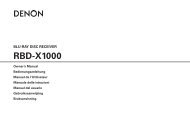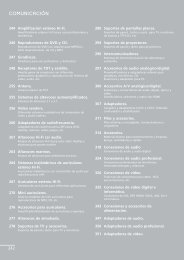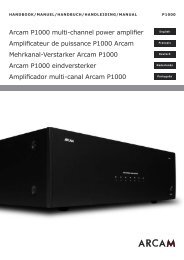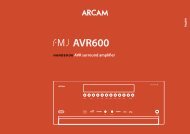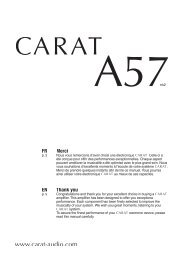Dynaudio SUB 300/500 - Studio 22
Dynaudio SUB 300/500 - Studio 22
Dynaudio SUB 300/500 - Studio 22
Sie wollen auch ein ePaper? Erhöhen Sie die Reichweite Ihrer Titel.
YUMPU macht aus Druck-PDFs automatisch weboptimierte ePaper, die Google liebt.
Positioning and Optimizing<br />
Positioning and Optimizing<br />
Positioning the subwoofer<br />
Although it is often said that the location of a subwoofer in a listening room is not critical<br />
(as the human ear can not locate direction at very low frequencies), we recommend that<br />
you choose its position carefully so the subwoofer can integrate fluently with the other<br />
speakers in the system and interact in the correct way with the acoustical environment.<br />
All of the following should be taken as rough guidelines; bass response in general is<br />
very dependent on the acoustics of the listening environment. Finding the best<br />
position often involves a lot of trial-and-error experimenting. Always trust your ears,<br />
even if seemingly the position of the subwoofer goes against the guidelines.<br />
Contradictory as it may seem, good integration of subwoofers has been achieved<br />
when one isn't aware that a subwoofer is present at all in the system, yet performance<br />
involves fast, deep and solid bass without sounding stressed, even at loud levels.<br />
• Trying to find the right location will also involve finding the right settings such as level,<br />
cross-over frequency and phase for that location. The subwoofer's presets will prove<br />
to be a useful tool when trying to find a suitable setting: You can store the settings that<br />
match a particular position so you can easily swap between locations. It will also allow<br />
you to make small changes in settings and to store these as separate presets. This<br />
way, you can compare between presets to find the best setting. Refer also to “Storing<br />
and Recalling Presets (PRESET)” on page 14.<br />
• When experimenting to find the optimal location, use a couple of music tracks with<br />
repetitive bass across a large spectrum. The tracks should be sufficiently different<br />
from each other and each should cover a wide bass-range. Musical instruments,<br />
such as a double-bass, bass guitar, church organ, etc. cover a wide spectrum in the<br />
bass region and are therefore very suitable. Using non-music (such as action<br />
movies) material to position and adjust the subwoofer with, may lead to spectacular<br />
results with such material but almost always it will result in overblown and excessive<br />
bass when playing music with the same setting. Remember that the <strong>Dynaudio</strong><br />
subwoofers allow for 4 different preset settings, so you can store a preset with the<br />
setting that matches the occasion (be it for action movie or music listening) best.<br />
Room modes<br />
1/4<br />
1/2<br />
3/4<br />
1/4<br />
1/2 3/4<br />
Listening room<br />
Every listening environment will have specific “room modes”, whereby in some<br />
specific locations in the room and at particular frequencies, the bass may be too much<br />
or too lean. This effect will be stronger in square and “shoe-box” shaped rooms. With<br />
a single subwoofer, the better position for the subwoofer relative to the listening<br />
position will be the one where bass is perceived to be neither too much or too lean at<br />
any given frequency.<br />
Generally, avoid placing the subwoofer at 1/4, 1/2 or 3/4 of either the length or<br />
width of the room as at these locations the room-modes are likely to be strongest<br />
(the dashed lines in the figure left).<br />
Moving the subwoofer closer to walls and corners in particular will generally increase<br />
the amount of bass. Although the extra amount of bass can be compensated for by<br />
reducing the volume level of the subwoofer relative to the rest of the system, this can<br />
result in uneven bass response at the listening position. You can try starting with<br />
placement in a corner and experiment by gradually moving it out of the corner or<br />
further away from the wall. Try to locate the position which yields the best compromise<br />
between position, volume and even bass response. Note that every time that you<br />
reposition the subwoofer (even if it's over a short distance) you may need to adjust<br />
the LEVEL and PHASE settings again.<br />
<strong>Dynaudio</strong> <strong>SUB</strong> <strong>300</strong>/<strong>500</strong> 15






